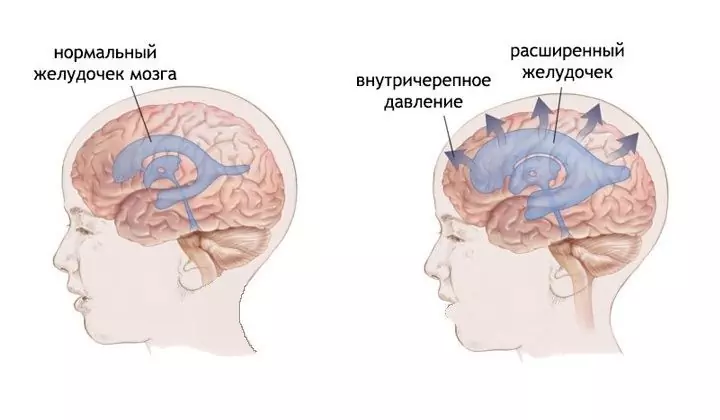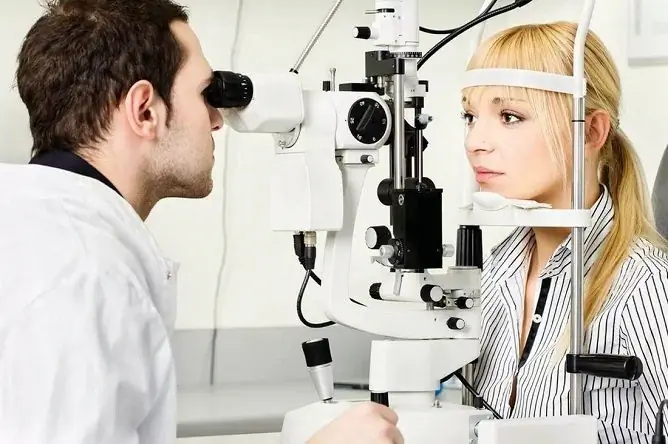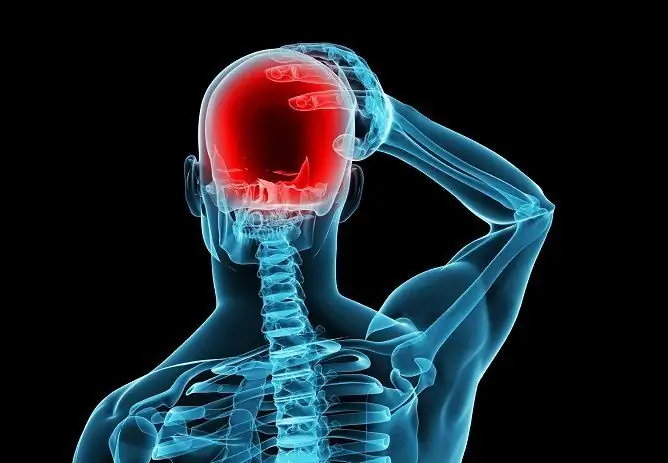- Author Rachel Wainwright [email protected].
- Public 2023-12-15 07:39.
- Last modified 2025-11-02 20:14.
Increased intracranial pressure
The content of the article:
- Causes
- Kinds
- Symptoms of increased intracranial pressure
- Increased intracranial pressure in children
- Diagnostics
- Treatment of increased intracranial pressure
- Prevention
- Possible consequences
Increased intracranial pressure (syndrome of increased intracranial pressure, intracranial hypertension, cerebrospinal fluid-hypertensive syndrome) is a clinical syndrome manifested by headache, nausea, vomiting, and recurrent visual disturbances.

Signs of increased intracranial pressure
Causes
The following reasons can lead to an increase in intracranial pressure:
- volumetric formation in the cranial cavity (brain abscess, cerebral aneurysm, hematomas, cysts, metastatic or primary brain tumors);
- cerebral edema - can be local or diffuse (general), develops against the background of toxic lesions, encephalitis, ischemic stroke, hepatic encephalopathy, hypoxia, brain contusion. With arachnoiditis and meningitis, edema of the meninges develops, which also leads to an increase in intracranial pressure;
- increased blood circulation in the brain - due to either a difficult outflow of blood from the brain through the venous system (discirculatory encephalopathy), or, conversely, increased inflow (hypercapnia, hyperthermia);
- violations of CSF dynamics - may be caused by a decrease in absorption, circulation disorder or an increase in the production of cerebral fluid (CSF). Violations of liquorodynamics always lead to an increased accumulation of fluid in the cranial cavity, i.e., to the development of hydrocephalus.
In some cases, increased intracranial pressure in adults, and sometimes in children, occurs under the influence of unknown causes (idiopathic form). Most often, this condition is observed in women who are obese. Therefore, some experts suggest that endocrine disorders play a certain role in the pathological mechanism of increased intracranial pressure. Also, in the formation of the idiopathic form of this clinical syndrome, the following may matter:
- abrupt withdrawal of corticosteroids, especially after a long course of use;
- taking certain medications;
- hypervitaminosis of vitamin A.

Idiopathic hypertension is common in obese women
The cranial cavity is a closed space with a limited volume, therefore, an increase in any of its structures leads to an increase in intracranial pressure. This, in turn, leads to compression of the brain of one degree or another, resulting in the development of metabolic disorders in nerve cells (neurons).
With a significant increase in intracranial pressure, the structures of the brain are displaced, that is, a dislocation syndrome develops - the cerebellar tonsils are wedged into the foramen magnum, which leads to compression of the brain stem, in which the respiratory and vasomotor nerve centers are located. The result is a violation of vital functions, which, if untimely provided medical care, can lead to death.
Kinds
The increase in intracranial pressure, depending on the cause, is divided into two forms:
- primary (idiopathic) - the exact cause cannot be established; differs in a benign course;
- secondary - develops as a complication of diseases and brain injuries.
According to the duration of the course, acute and chronic forms of increased intracranial pressure are distinguished. The acute form usually develops against the background of neuroinfectious processes, craniocerebral trauma. The causes of chronic increased intracranial pressure in adults and children are quite often slowly growing masses (cysts, tumors), vascular disorders. Often, the chronic form of the syndrome becomes a residual consequence of toxic encephalopathy, stroke, infections, trauma and a number of other acute cerebral processes, as well as neurosurgical operations.
Symptoms of increased intracranial pressure
The main symptom of increased intracranial pressure is headache. In the acute form of the syndrome, its intensity increases rapidly, and in chronic pain it is constant, with periodic bouts of intensification. Headache with increased intracranial pressure is usually localized in the frontal-parietal areas, is bursting in nature and is accompanied by a feeling of pressure from the inside on the eyeballs. Often, it is accompanied by nausea, and with significant intracranial hypertension, patients experience vomiting, up to indomitable.

Headache is the main symptom of increased intracranial pressure
With a chronic increase in intracranial pressure, the general condition worsens. Increased meteosensitivity, rapid mental and physical fatigue, sleep disturbances, irritability develop. A sharp and significant increase in intracranial pressure leads to disorders of consciousness - from mild stunnedness to severe coma.
Symptoms of increased intracranial pressure are also impaired visual function:
- decreased visual acuity;
- double vision (diplopia);
- blurring of the contours of the observed objects.
A secondary increase in intracranial pressure is always accompanied by symptoms of the underlying pathology (focal, cerebral, intoxication, general infectious).
Increased intracranial pressure in children
Causes of increased intracranial pressure in children:
- asphyxia of newborns;
- fetal hypoxia;
- intrauterine infections;
- intracranial birth trauma;
- arteriovenous malformation of the brain;
- congenital hydrocephalus;
- microcephaly.
In children, the syndrome has a subclinical course for a long time, i.e., without a vivid clinical picture. This is due to the increased elasticity and pliability of the cranial sutures, as well as the relative softness of the cranial bones characteristic of the first years of life.

Bulging fontanelle in infants may indicate increased intracranial pressure
Increased intracranial pressure in children of the first year of life is manifested by the following symptoms:
- rejection of the breast;
- anxiety;
- moodiness, tearfulness;
- frequent profuse regurgitation;
- bulging fontanelle;
- oculomotor disorders.
Diagnostics
Diagnosis of increased intracranial pressure, as well as assessment of the severity of the syndrome, present certain difficulties. This is primarily due to the fact that the value of intracranial pressure is not constant and is subject to pronounced fluctuations during the day. Normally, it is 70-220 mm of water column.
Echoencephalography allows you to obtain indicative data, but they should be evaluated only in combination with the data of the clinical picture.
X-ray of the skull in patients with long-term increased intracranial pressure reveals a characteristic sign - "digital impressions".

One of the types of diagnostics of increased intracranial pressure is echoencephalography
It is possible to reliably measure intracranial pressure by performing a puncture of the ventricles and introducing a special electronic sensor into them. This is an invasive procedure that requires the creation of a trepanning hole in the skull, and therefore it is performed only in a neurosurgical hospital.
To identify the underlying pathology that led to an increase in intracranial pressure, perform:
- Doppler ultrasound of the blood vessels of the head;
- neurosonography (in children of the first year of life, until the large fontanelle closes);
- magnetic resonance imaging, computed (multispiral computed) tomography;
- laboratory examination (clinical, biochemical, cytological) of cerebrospinal fluid;
- stereotactic biopsy of brain neoplasms with subsequent histological and cytological examination of the resulting tissue.
If an increase in intracranial pressure is suspected, the patient should be consulted by an ophthalmologist with a mandatory examination of the eye day. A characteristic change for this condition is swelling of the optic nerve head.
Treatment of increased intracranial pressure
Conservative therapy is carried out with a chronic or residual increase in intracranial pressure without signs of rapid progression. In the acute form of the syndrome, conservative tactics are justified with a slow increase in intracranial hypertension, the absence of signs of dislocation syndrome and pronounced disturbances of consciousness.
Drug treatment of increased intracranial pressure is carried out with diuretics (hydrochlorothiazide, spironolactone, furosemide, mannitol). Dosages, frequency and duration of use are determined by the doctor based on the patient's condition. Therapy with many types of diuretics requires additional prescription of potassium preparations (potassium chloride, Asparkam, Panangin).

Drug treatment of increased intracranial pressure is the use of diuretics
Simultaneously with the correction of the level of intracranial pressure, active treatment of the underlying pathology is carried out. For infectious diseases, antibiotics or antiviral drugs are prescribed. For vascular disorders, venotonics (hesperidin with diosmin, horse chestnut extract) or vasoactive therapy (nifedipine, vinpocetine, aminophylline) are indicated.
In the complex treatment of increased intracranial pressure, drugs with a neurometabolic effect are used (hydrolyzate of the pig's brain, glycine, piracetam, γ-aminobutyric acid). Cranial manual therapy can improve the venous outflow from the brain.
With an acute increase in intracranial pressure or during an exacerbation of a chronic form, the patient is advised to limit all types of activities with a load on vision (reading books, watching television, working at a computer, knitting), and also to refuse listening to music through headphones.
With the development of dislocation syndrome, in order to save the patient's life, an emergency surgical intervention is performed - decompression craniotomy. If indicated, external ventricular drainage may be performed.
In order to eliminate the cause of the increase in intracranial pressure, planned surgical operations (cerebral bypass surgery to eliminate hydrocephalus, correction of congenital anomalies, removal of intracranial volumetric neoplasms, etc.) may be indicated.
Prevention
Prevention of the development of intracranial hypertension includes:
- timely and active treatment of neuroinfectious diseases;
- prevention of craniocerebral injuries;
- timely correction of disorders of liquorodynamics, blood circulation;
- rational management of pregnancy and childbirth;
- avoidance of mental and physical overload;
- compliance with the daily routine;
- rejection of bad habits.
Possible consequences
The consequences of increased intracranial pressure are determined by many factors, in particular, the duration of the syndrome, the compensatory capabilities of the body, the timeliness of the initiation of therapy.
With a rapid increase in intracranial pressure and the development of dislocation syndrome, a lethal outcome is possible.
The idiopathic form of increased intracranial pressure responds well to conservative therapy and has a positive prognosis.
A chronic increase in intracranial pressure in children can lead to a delay in the child's mental development up to the formation of severe forms of oligophrenia (idiocy).
YouTube video related to the article:

Elena Minkina Doctor anesthesiologist-resuscitator About the author
Education: graduated from the Tashkent State Medical Institute, specializing in general medicine in 1991. Repeatedly passed refresher courses.
Work experience: anesthesiologist-resuscitator of the city maternity complex, resuscitator of the hemodialysis department.
The information is generalized and provided for informational purposes only. At the first sign of illness, see your doctor. Self-medication is hazardous to health!






